Performance Analysis of Multi-OEM TV White Space Radios in Outdoor Environments
Abstract
1. Introduction
1.1. Characteristics of Radio Communication Equipment Operating in the TVWS Spectrum
1.2. Underlying TVWS Regulatory Framework
1.3. Equipment Type Approval Certification
1.4. Underlying Technical Standards and Protocols
1.5. Potential Benefits of the TVWS Spectrum
- Cost-effectiveness: The TVWS spectrum significantly reduces the total cost of ownership (TCO) for network operators by leveraging the unlicensed or lightly licensed spectrum. This dramatically reduces spectrum licensing fees. In addition, TVWS devices are capable of operating over long distances due to the favourable propagation characteristics of UHF frequencies. This extended coverage range enables operators to deploy fewer base stations or relay nodes, thereby reducing infrastructure requirements and capital expenditures. Together, these factors make TVWS a highly cost-effective solution for delivering broadband connectivity, especially in rural or low-density areas.
- Lower interference, better QoS: TVWS equipment operates with reduced interference primarily due to regulatory frameworks that mandate the use of GLSDs. Unlike the unlicensed industrial, scientific, and medical (ISM) bands (e.g., 2.4 GHz and 5 GHz), where Wi-Fi devices operate without centralised coordination and are prone to congestion, TVWS devices must query the GLSD to determine which frequencies are available in a specific geographic location. This approach ensures that devices avoid channels that are already in use by licensed incumbent services. This significantly minimises the risk of harmful interference and enables better QoS for end users.
- Improved SUE: Dynamic spectrum sharing maximises the efficient utilisation of finite spectrum resources, which are necessary to expand national wireless ICT infrastructure.
- Creation of job opportunities through accessible technology: By leveraging the TVWS spectrum, which has a low barrier to entry, ICT-focused youth- and women-owned SMMEs can deploy affordable wireless broadband infrastructure. This contributes towards bridging the digital divide and empowering local communities by creating employment opportunities for women and young entrepreneurs.
1.6. Related Work
- Providing the first comparative, field-based evaluation of multiple OEM TVWS communication equipment operating under dynamic spectrum regulations using a standardised test protocol in South Africa.
- Providing a valuable foundation for OEMs, network planners, operators, researchers, and regulators to understand and inform the design of next-generation dynamic spectrum sharing communication equipment, network deployments, and regulations.
2. Experimental Methodology
2.1. Defining the Evaluation Scenarios
2.2. Defining the Performance Metrics
- Spectrum utilisation efficiency (SUE): This is a measure of how WSDs under test utilise the available spectrum in a channel.
- Received signal strength (RSS): This is a measure of the power level that a WSD detects from a transmitted signal. RSS is typically expressed in decibels relative to a milliwatt (dBm) and indicates how strong or weak the signal is at the receiver’s location. Higher (less negative) RSS values generally represent stronger signals, which can lead to better communication quality and reliability.
- Downlink throughput: The rate at which data are successfully delivered from a network to a user device over a given period is the downlink throughput. It is typically expressed in megabits per second (Mbps) and reflects the actual data transfer speed from the Master WSD to the user equipment (e.g., smartphones, laptops, or Client WSDs). It is influenced by factors such as signal quality, interference, and network congestion.
- GLSD connectivity: This indicates how well the Master WSD under test interacts with the GLSD/Spectrum Switch in compliance with the South African TVWS regulatory framework [16].
2.3. Validation of Results
3. Experimental Equipment, Tools, and Parameters
3.1. WSDs Under Test
- OEM 3: The WSDs from OEM 3 are based on the 3GPP LTE-A Standard [68,69]. Figure 4 depicts the Master WSD from OEM 3 deployed on the rooftop of building 43C at CSIR’s Scientia campus in Pretoria. Figure 4 also depicts the Client WSD from OEM 3 deployed at the rooftop of a residential house in Pretoria East.
3.2. Measurement Tools
- Rohde & Schwarz Spectrum Analyser Model FSH4 (100 kHz–3.6 GHz) (Munich, Germany): This tool was used to collect RSS measurements as well as the channel spectrum occupancy measurements during the experiment. As depicted in Figure 5, a 60 dB attenuator was used to reduce the power of the signal, to protect the spectrum analyser from any damage due to excessive RF input power exceeding the device’s maximum input tolerance. The laptop was used to configure a Master WSD.
- LigoWave LinkCalc (Vilnius, Lithuania) [70]: This tool was used to perform radio propagation prediction and coverage analysis before deployment. It provided estimates of signal strength, path loss, and potential interference zones, helping to determine optimal antenna placement and ensure reliable communication links between the WSDs
- iPerf [71]: This tool was installed on test devices to measure point-to-point transmission control protocol (TCP) and user datagram protocol (UDP) throughput between a Master and Client WSD. It enabled precise control over test parameters such as packet size, test duration and protocol, allowing for a detailed evaluation of network performance under controlled conditions.
- Google/M Lab [72]: This cloud-based measurement platform was used to assess internet throughput and latency from the Client WSDs to remote test servers. It was used to evaluate real-world end-to-end performance, in terms of download/upload speed, and network responsiveness when accessing public internet services.
- Ookla [73]: This tool was employed to validate internet performance metrics from various WSD locations. It provided user-friendly, widely recognised benchmarks for download/upload speeds and latency, complementing the more technical iPerf and M-Lab measurements with results comparable to real-world user experiences. These tests (like most tests using the previously mentioned tools) were repeated for several different Master and Client WSDs for Scenario 1 and 2, relative to the Master WSD antenna for each OEM. At each distance, the speed measurements were repeated five times, and the averages and standard deviations were estimated.
- CSIR S-GLSD, also known as Spectrum Switch: In compliance with the South African TVWS regulatory framework, this system was used to dynamically assign the TVWS spectrum to the WSDs under test [27].
3.3. WSD Configuration Parameters
4. Performance Evaluation
4.1. Received Signal Strength and Downlink Throughput
- = the basic transmission loss (dB);
- d = the distance between transmitter and receiver (m);
- f = the frequency (Hz);
- 147.55 = the constant for path loss in free space.
- = the RSS (mW);
- = the transmit power (mW);
- = the transmit antenna gain (dBi);
- = the received antenna gain (dBi);
- = the basic transmission loss (dB).
- = the WSD noise power (mW);
- −174 = the WSD thermal noise density estimated at 290 K room temperature (dBm/Hz);
- = the system bandwidth (Hz);
- = the WSD noise figure (dB).
- = the channel capacity (Mbps);
- B = the channel bandwidth (Hz);
- = the received signal power (mW);
- = the WSD noise power (mW).
- = the measured values at location ;
- = the predicted values at location ;
- = the number of observation results.
4.2. Spectrum Utilisation Efficiency
- = the SUE per channel (%);
- = the occupied bandwidth in a single TVWS channel (MHz);
- = a single TVWS channel width (MHz).
5. Results and Discussion
5.1. Spectrum Utilisation Efficiency
5.2. Scenario 1: Outdoor Short-Distance (RSS and Throughput Performance Metrics)
5.3. Scenario 2: Outdoor Long-Distance (RSS and Throughput) Performance Metrics
5.4. S-GLSD Connectivity
- S-GLSD Discovery: The Master WSD retrieves certified S-GLSD provider details (including PAWS URLs) from the R-GLSD web list. Discovery occurs at startup and refreshes periodically based on the ‘maxRefreshMinutes’ value in the response, ensuring up-to-date GLSD instance data.
- S-GLSD Communication: The Master WSD initiates communication by sending an INIT request on startup or whenever the S-GLSD configurations have changed. It then registers itself (approval required before client registration). Registration is also triggered by provider/instance changes, ownership updates, or location shifts exceeding 100m (but not for location changes of less than 100m). The Master then requests operational parameters (OPs) for itself and clients. It refreshes them after registration, INIT, or expiry (24 h for fixed WSD or 12 h for nomadic WSD). Finally, the Master WSD notifies the S-GLSD of channel usage within 60 s of receiving OPs, prioritising its notification before that of the clients.
- Cease Transmission: The Master WSD does not transmit if it cannot connect to the S-GLSD and its OPs are invalid. Similarly, Client WSDs only transmit after receiving a verification signal from the Master and with valid OPs. Both must cease transmission within 60 s (Master) or 10 s (Client) if channel usage notification or contact verification fails. If connectivity issues persist, transmission stops once OPs expire, ensuring compliance with validity periods.
- Continuous Operation: During S-GLSD connectivity loss, WSDs are permitted to renew the OPs for an additional validity period automatically. Thus, fixed WSDs have an extended validity of up to 48 h in total, whereas nomadic WSDs have up to 24 h. Both Master and Client WSDs may continue operating post OPs expiry under these conditions. Furthermore, the WSDs are permitted to transmit whenever S-GLSD discovery fails, but existing OPs remain valid (including those with extended validity). On startup, both WSD types continue transmitting if their current OPs are still valid, ensuring uninterrupted service while remaining compliant with validity periods.
- Ruleset Configuration: WSDs dynamically adapt to user configurations, including S-GLSD provider/instance choice, API security (API Key/Bearer Token), ownership details, and antenna characteristics. The Master WSD auto-configures its location via internal/external GPS. Optional regulatory or proprietary settings can also be configured for flexible operation.
6. Conclusions
Author Contributions
Funding
Institutional Review Board Statement
Informed Consent Statement
Data Availability Statement
Conflicts of Interest
References
- Elshafie, H.; Fisal, N.; Abbas, M.; Hassan, W.A.; Mohamad, H.; Ramli, N.; Jayavalan, S.; Zubair, S. A survey of cognitive radio and TV white spaces in Malaysia. Trans. Emerg. Telecommun. Technol. 2014, 26, 975–991. [Google Scholar] [CrossRef]
- Anabi, K.H.; Nordin, R.; Abdullah, N.F. Database-Assisted Television White Space Technology: Challenges, Trends and Future Research Directions. IEEE Access 2016, 4, 8162–8183. [Google Scholar] [CrossRef]
- ICASA. Radio Frequency Spectrum Assignment Plan for the 470 to 694 MHz Frequency Band. Available online: https://www.icasa.org.za/news/2020/radio-frequency-spectrum-assignment-plan-for-the-470-to-694-mhz-frequency-band (accessed on 21 August 2025).
- Moshe, T.M.; Makgotlho, R.; Mekuria, F. Setting the Scene for TV White Spaces and Dynamic Spectrum Access in South Africa. In Proceedings of the IST-Africa 2012 Conference, Dar es Salaam, Tanzania, 9–11 May 2012. [Google Scholar]
- Kruger, A. The Power of Wireless Internet in Rural Areas: A Game-Changer for South Africa. Available online: https://adnotes.co.za/the-power-of-wireless-internet-in-rural-areas-a-game-changer-for-south-africa/ (accessed on 21 August 2025).
- Lysko, A.A.; Masonta, M.T.; Johnson, D.L. The Television White Space Opportunity in Southern Africa: From Field Measurements to Quantifying White Spaces. In White Space Communication; Spinger: Berlin/Heidelberg, Germany, 2014. [Google Scholar] [CrossRef]
- Mthethwa, N.; Sebopetse, N.; Vilakazi, M.; Mfupe, L.; Mofolo, M.; Mekuria, F. Sustainable Internet4All in South African Rural and Township Communities. In Proceedings of the 2023 IEEE Africon, Nairobi, Kenya, 20–22 September 2023; pp. 1–6. [Google Scholar] [CrossRef]
- Ramoroka, M.T.; Masonta, M.T.; Kliks, A. TV White Space Networks Deployment: A Case Study of Mankweng Township in South Africa. In e-Infrastructure and e-Services; Springer: Cham, The Netherlands, 2016; Volume 171, pp. 3–13. [Google Scholar] [CrossRef]
- Lysko, A.A.; Masonta, M.T.; Mofolo, M.R.; Mfupe, L.; Montsi, L.; Johnson, D.L.; Mekuria, F.; Ngwenya, D.W.; Ntlatlapa, N.S.; Hart, A.; et al. First Large TV White Spaces Trial in South Africa: A Brief Overview. In Proceedings of the 2014 6th International Congress on Ultra Modern Telecommunications and Control Systems and Workshops (ICUMT), St. Petersburg, Russia, 6–8 October 2014. [Google Scholar] [CrossRef]
- Mfupe, L.; Mekuria, F.; Mzyece, M. Geo-location White Space Spectrum Database: Models and Design of South Africa’s First Dynamic Spectrum Access Coexistence Manager. KSII Trans. Internet Inf. Syst. 2014, 8, 3810–3836. [Google Scholar] [CrossRef]
- Masonta, M.T.; Ramoroka, T.M.; Lysko, A.A. Using TV White Spaces and e-Learning in South African rural schools. In Proceedings of the 2015 IST-Africa Conference, Lilongwe, Malawi, 6–8 May 2015; pp. 1–12. [Google Scholar] [CrossRef]
- Masonta, M.T.; Kola, L.M.; Lysko, A.A.; Pieterse, L.; Velempini, M. Network Performance Analysis of the Limpopo TV White Space (TVWS) Trial Network. In Proceedings of the AFRICON 2015, Addis Ababa, Ethiopia, 14–17 September 2015. [Google Scholar] [CrossRef]
- Kaliappan, E.; Madhevan, P.R.; Ram, A.S.A.; Ponkarthika, B.; Abinesh, M.R. Remote Surveillance and Communication Using Television White Space. In Innovative Data Communication Technologies and Application; Springer: Singapore, 2021. [Google Scholar] [CrossRef]
- Mfupe, L.; Dzinotyiweyi, C.; Pillay, K. Rural TVWS Network Operators Support Programme. In Final Impact Report-Phase II.; Council for Scientific and Industrial Research (CSIR): Pretoria, South Africa, 2024; Available online: https://heyzine.com/flip-book/13ceb871f5.html (accessed on 24 July 2024).
- Hussein, H.M.; Katzis, K.; Mfupe, L.P.; Bekele, E.T. Performance Optimization of High-Altitude Platform Wireless Communication Network Exploiting TVWS Spectrums Based On Modified PSO. IEEE Open J. Veh. Technol. 2022, 3, 1–11. [Google Scholar] [CrossRef]
- Independent Communication Authority of South Africa. Electronic Communication Act, 2005 (Act no. 36 of 2005): Regulations on the Use of Television White Spaces (Notice 147 of 2018), 23 March 2018. Available online: https://www.icasa.org.za/legislation-and-regulations/regulations-on-the-use-of-television-white-spaces-2018 (accessed on 30 August 2025).
- Lamola, M.M.; Johnson, D.; Lysko, A.A.; Zlobinsky, N. TVWS Devices Spectrum Mask Test and Analysis. In Proceedings of the 2016 Southern African Telecommunications Networks and Applications Conference (SATNAC), Western Cape, South Africa, 4–7 September 2016. [Google Scholar]
- Toheeb, O. TV White Space Technology and Its Use in Rural Broadband. 2025. Available online: https://www.researchgate.net/publication/392662880_TV_White_Space_Technology_and_Its_Use_in_Rural_Broadband (accessed on 5 June 2025).
- Federal Communications Commission (FCC). Cable Television, FCC Media Engineering. Available online: https://www.fcc.gov/media/engineering/cable-television (accessed on 21 August 2025).
- Nyasulu, T.; Crawford, D.H.; Mikekaa, C. Malawi’s TV white space regulations: A review and comparison with FCC and Ofcom regulations. In Proceedings of the 2018 IEEE Wireless Communications and Networking Conference (WCNC), Barcelona, Spain, 15–18 April 2018; pp. 1–6. [Google Scholar] [CrossRef]
- Noguet, D.; Gautier, M.; Berg, V. Advances in opportunistic radio technologies for TVWS. EURASIP J. Wirel. Commun. Netw. 2011, 2011, 1–12. [Google Scholar] [CrossRef]
- Holland, O.; Sastry, N.; Ping, S.; Knopp, R.; Kaltenberger, F.; Nussbaum, D.; Hallio, J.; Jakobsson, M.; Auranen, J.; Ekman, R.; et al. A series of trials in the UK as part of the Ofcom TV white spaces pilot. In Proceedings of the 2014 1st International Workshop on Cognitive Cellular Systems (CCS), Duisburg, Germany, 2–4 September 2014; pp. 1–5. [Google Scholar] [CrossRef]
- Infocomm Media Development Authority (IMDA). TV White Space, IMDA. Available online: https://www.imda.gov.sg/regulations-and-licensing-listing/spectrum-management/spectrum-planning/tv-white-space (accessed on 21 August 2025).
- Calinao, H.A.; Jr, L.M.; Takada, J.; Trinidad, E.; Homma, K.; Ota, K.; Mazlan, S.A.; Rambat, S. Development of a Material for Gauging Sustainable Transitions Towards Adoption and Implementation of Television White Space Communications Systems. Int. J. Emerg. Technol. Adv. Eng. 2021, 11, 39–57. [Google Scholar] [CrossRef] [PubMed]
- EN 301 598 V1.1.1; White Space Devices (WSD); Wireless Access Systems Operating in the TV Broadcast White Spaces; Harmonized EN Covering the Essential Requirements of Article 3.2 of the R&TTE Directive. ETSI: Valbonne, France, 2014.
- EN 62368-1; Audio/Video, Information and Communication Technology Equipment—Safety Requirements. CENELEC: Brussels, Belgium, 2020.
- Council for Scientific and Industrial Research. About: The S-GLSD, 25 November 2024. Available online: https://whitespaces.csir.co.za/public/about (accessed on 30 August 2025).
- CISPR 32; Electromagnetic Compatibility of Multimedia Equipment —Emission Requirements. International Electrotechnical Commission (IEC): Geneva, Switzerland, 2015.
- EN 301 489-1; ElectroMagnetic Compatibility (EMC) Standard for Radio Equipment and Services; Part 1: Common Technical Requirements. European Telecommunications Standards Institute (ETSI): Sophia Antipolis Cedex, France, 2019.
- IEC 60950-1; Information Technology Equipment —Safety —Part 1: General Requirements. IEC: Geneva, Switzerland, 2005.
- IEC 62368-1; Audio/Video, Information and Communication Technology Equipment —Part 1: Safety Requirements. IEC: Geneva, Switzerland, 2023.
- Rahman, M.; Saifullah, A. A comprehensive survey on networking over TV white spaces. Pervasive Mob. Comput. 2019, 59, 1–30. [Google Scholar] [CrossRef]
- Zhang, W.; Yang, J.; Zhang, G.; Yang, L.; Yeo, C.K. TV white space and its applications in future wireless networks and communications: A survey. IET Commun. 2018, 12, 2521–2532. [Google Scholar] [CrossRef]
- Zeng, Y.; Liang, Y.C.; Lei, Z.; Oh, S.W.; Chin, F.; Sun, S. Worldwide Regulatory and Standardization Activities o Cognitive Radio. In Proceedings of the 2010 IEEE Symposium on New Frontiers in Dynamic Spectrum (DySPAN), Singapore, 6–9 April 2010; pp. 1–9. [Google Scholar]
- OFCOM. Ofcom Progresses with New Wireless Technology. Available online: https://www.medialaws.eu/uk-ofcom-progresses-with-new-wireless-technology/ (accessed on 2 September 2011).
- ETSI EN 301 489; (Series Overview): “ElectroMagnetic Compatibility (EMC) Standard for Radio Equipment and Services.”. ETSI: Sophia Antipolis Cedex, France.
- EN 301 489-17; ElectroMagnetic Compatibility (EMC) Standard for Radio Equipment; Part 17: Specific Conditions for 2.4 GHz Wide-Band Transmission Systems, 5 GHz High-Performance RLAN Equipment and 5.8 GHz Broadband Data Transmitting Systems. ETSI: Sophia Antipolis Cedex, France.
- BS EN IEC 62368-1:2024+A11:2024; Audio/Video, Information and Communication Technology Equipment—Safety Requirements. British Standards Institution: London, UK, 2024.
- Leong, S.; Lee, T. Internet Governance: Singapore’s Regulatory Influence. In Global Internet Governance: Influences from Malaysia and Singapore; Springer: Singapore, 2020; pp. 71–90. [Google Scholar]
- Haenig, M.A.; Ji, X. A tale of two Southeast Asian states: Media governance and authoritarian regim10.es in Singapore and Vietnam. Asian Rev. Political Econ. 2024, 3, 4. [Google Scholar] [CrossRef]
- Ante, M.G.; Molina, J.A.; Trinidad, E.; Materum, L. A survey and comparison of TV white space implementations in Japan, the Philippines, Singapore, the United Kingdom, and the United States. Int. J. Adv. Technol. Eng. Explor. 2021, 8, 780. [Google Scholar] [CrossRef]
- Directive 2014/53/EU; (Radio Equipment Directive, RED). European Union, Official Journal of the European Union: Luxembourg, 2014.
- European Parliament and Council. Directive 2014/53/EU on the Harmonisation of the Laws of the Member States Relating to the Making Available on the Market of Radio Equipment (Radio Equipment Directive); Publications Office of the European Union: Luxembourg, 2014. [Google Scholar]
- Bañacia, A.S.; Ferolin, R.J.; Sawada, H.; Ishizu, K.; Ibuka, K.; Matsumura, T.; Kojima, F. Coexistence of a Low-power IEEE 802.11 af Secondary User in TV White Space with Analog and Digital TV systems. In Proceedings of the 2021 24th International Symposium on Wireless Personal Multimedia Communications (WPMC), Okayama, Japan, 14–16 December 2021; pp. 1–6. [Google Scholar]
- Foo, Y.L. Harmonious Coexistence of IEEE 802.11 af Wireless LAN and Digital TV. IETE Tech. Rev. 2021, 38, 239–244. [Google Scholar] [CrossRef]
- Reddy, V.A.; Stüber, G.L. Implementation of the IEEE 802.11 af standard on ns-3. In Proceedings of the 2018 Workshop on NS-3 (WNS3 2018), Mangalore, India, 13–14 June 2018. [Google Scholar]
- Vithanawasam, C.K. Design and Analysis of TVWS Antenna for Rural Wireless Connectivity. Doctoral Dissertation, Swinburne University of Technology, Kuching, Malaysia, 2021. [Google Scholar]
- Dixit, S.; Dutta, A.; Agrawal, S.; Olivas, M.A.; Bhatia, V.; Carrillo, C.D.A.; Jha, P.; Jabhera, M.; Karna, A.; Khanganba, S.P.; et al. Connecting the unconnected. In Proceedings of the 2023 IEEE Future Networks World Forum (FNWF), Baltimore, MD, USA, 13–15 November 2023; pp. 1–88. [Google Scholar]
- Oluwafemi, I.B.; Bamisaye, A.P.; Faluru, M.A. Quantitative estimation of TV white space in Southwest Nigeria. Telecommun. Comput. Electron. Control 2021, 19, 36–43. [Google Scholar] [CrossRef]
- Ismail, M.; Kissaka, M.; Mafole, P. Capacity Analysis of a Television White Space Network Deployed under Distance Distribution Approach. Tanzan. J. Sci. 2021, 47, 214–227. [Google Scholar]
- Mei, R.; Wang, Z. Multi-Agent Deep Reinforcement Learning-Based Resource Allocation for Cognitive Radio Networks. IEEE Trans. Veh. Technol. 2024, 74, 4744–4757. [Google Scholar] [CrossRef]
- Saghir, M.H. Spectrum Allocation Strategies for Future Wireless Networks. Master’s Thesis, Chalmers University of Technology, Gothenburg, Sweden, 2015. [Google Scholar]
- Lysko, A.A. Work in television white spaces (TVWS) and dynamic spectrum and a bit on antennas. In Proceedings of the South African IEEE Joint AP/MTT/EMC Chapter Conference 2016, Stellenbosch, South Africa, 28–19 July 2016. [Google Scholar]
- Espinosa, M.; Perez, M.; Zona, T.; Lagrange, X. Radio Access Mechanism for Massive Internet of Things Services Over White Spaces. IEEE Access 2021, 9, 120911–120923. [Google Scholar] [CrossRef]
- Buitrago, M.E. Cognitive Radio Architecture for Massive Internet of Things services with Dynamic Spectrum Access. Ph.D. Thesis, Universitat Politècnica de València, Valencia, Spain, 2021. [Google Scholar]
- Guimarães, D.A. Spectrum Hole Geolocation for Database-Driven IoT-Enabled Dynamic Spectrum Access. IEEE Access 2025, 13, 64199–64215. [Google Scholar] [CrossRef]
- Buddhikot, M.M. Understanding dynamic spectrum access: Models, taxonomy and challenges. In Proceedings of the 2007 2nd IEEE International Symposium on New Frontiers in Dynamic Spectrum Access Networks, Dublin, Ireland, 17–20 April 2007; pp. 649–663. [Google Scholar]
- Microsoft Research. Microsoft’s White Space Trial in North Carolina. 2011. Available online: https://www.microsoft.com/en-us/research/project/dynamic-spectrum-and-tv-white-spaces/ (accessed on 27 September 2010).
- Ofcom. TV White Spaces Pilot: Trial Evaluation Report, UK. 2015. Available online: https://www.ofcom.org.uk (accessed on 12 February 2012).
- Lopez-Benitez, M.; Casadevall, F. Spectrum usage models for the analysis, design and simulation of cognitive radio networks. EURASIP J. Wirel. Commun. Netw. 2012, 2012, 273. [Google Scholar]
- Infocomm Media Development Authority. TV White Space Trials in Singapore, IMDA. 2016. Available online: https://www.imda.gov.sg (accessed on 23 May 2017).
- Masonta, M.T.; Kliks, A.; Mzyece, M. Television White Space (TVWS) Access Framework for Developing Regions. In Proceedings of the IEEE Africon 2013 Workshop: Cognitive radio and Opportunistic TVWS Broadband Wireless Networks for broadband internet provision in Emerging Economies, Mauritius, South Africa, 9–12 September 2013. [Google Scholar]
- Innonet. Service Construction. Available online: https://innonet.net:49248/eng/html/service_construction.php (accessed on 21 August 2025).
- Innonet. Product Detail. Available online: https://innonet.net:49248/eng/html/product_detail.php?pid=1 (accessed on 21 August 2025).
- NZIA. About Us. Available online: https://www.nzia.kr/about-us (accessed on 21 August 2025).
- NZIA. Whitepaper (v1). Available online: https://www.nzia.kr/_files/ugd/21ad4e_69b23aa3789c4d3096e95d309d73cf4e.pdf (accessed on 21 August 2025).
- NZIA. Whitepaper (v2). Available online: https://www.nzia.kr/_files/ugd/21ad4e_17af55fe91494c19a13a3fbee9175111.pdf (accessed on 21 August 2025).
- WiFrost. Products. Available online: https://www.wifrost.com/product (accessed on 21 August 2025).
- WiFrost. WiFrost Starter Guide. Available online: https://wifrost.notion.site/WiFrost-Starter-Guide-bffc94b2be7548148ed624f6d7361cbd (accessed on 21 August 2025).
- Ramirez, S.; Jiménez, F.; Reynoso, W.E.C.; Alcantara, E. Implementation WiMAX Stations. In Proceedings of the 13th Latin American and Caribbean Conference for Engineering and Technology: Engineering Education Facing the Grand Challenges, What Are We Doing? Santo Domingo, Dominican Republic, 29–31 July 2015. [Google Scholar] [CrossRef]
- Zieliński, B. Assessment of iPerf as a Tool for LAN Throughput Prediction. Int. J. Electron. Telecommun. 2023, 69, 523–528. [Google Scholar] [CrossRef]
- Feamster, N. Measuring internet speed: Current challenges and future recommendations. Commun. ACM 2020, 63, 72–80. [Google Scholar] [CrossRef]
- MacMillan, K.; Mangla, T.; Saxon, J.; Marwell, N.P.; Feamster, N. A Comparative Analysis of Ookla Speedtest and Measurement Labs Network Diagnostic Test (NDT7). ACM SIGMETRICS Perform. Eval. Rev. 2023, 51, 41–42. [Google Scholar] [CrossRef]
- CSIR Whitespaces. TVWS Device Ruleset Test Cases. Available online: https://whitespaces.csir.co.za/public/guideline/document/49/TVWS_Device_Ruleset_Test_Cases.pdf (accessed on 21 August 2025).




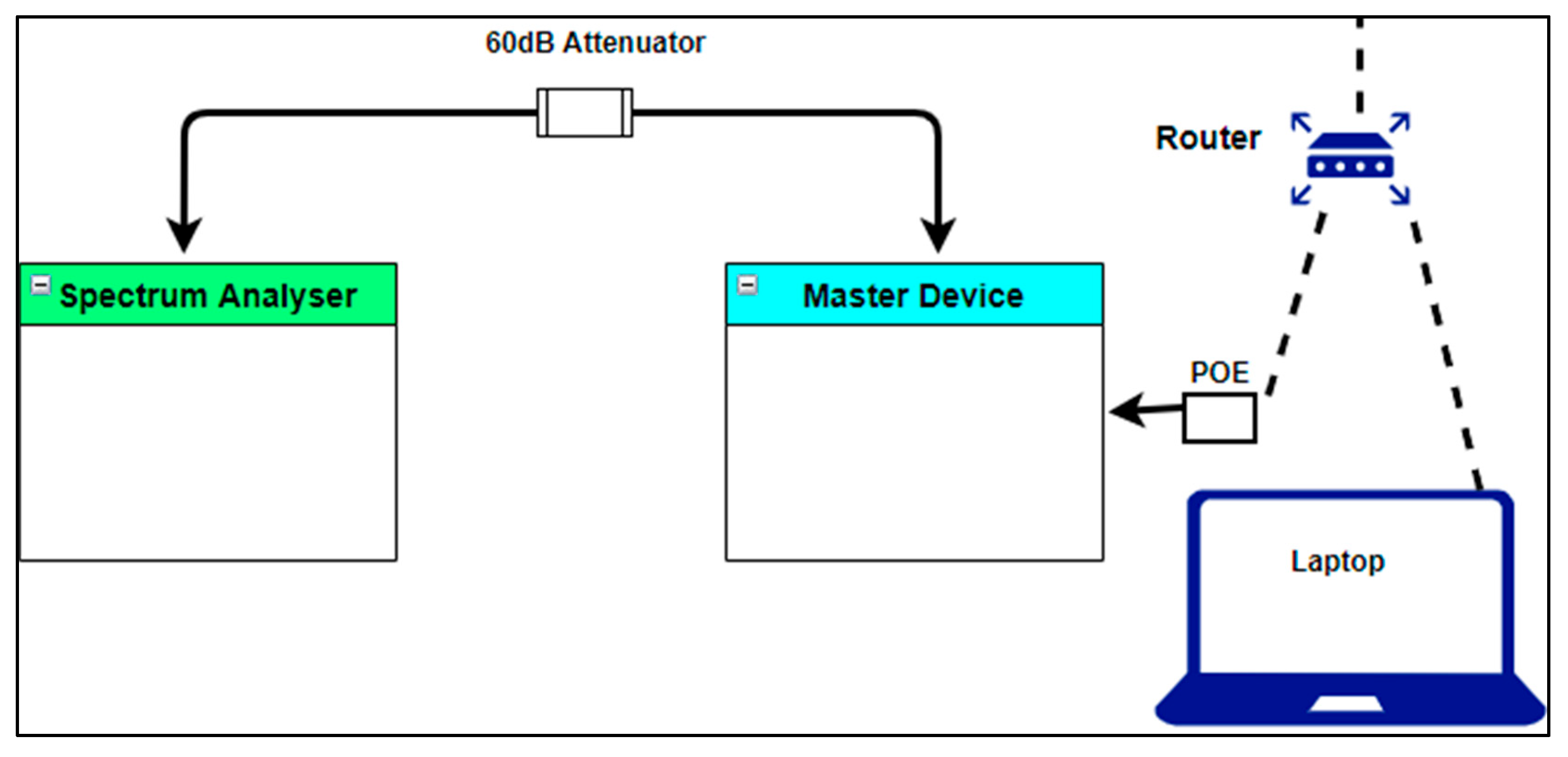

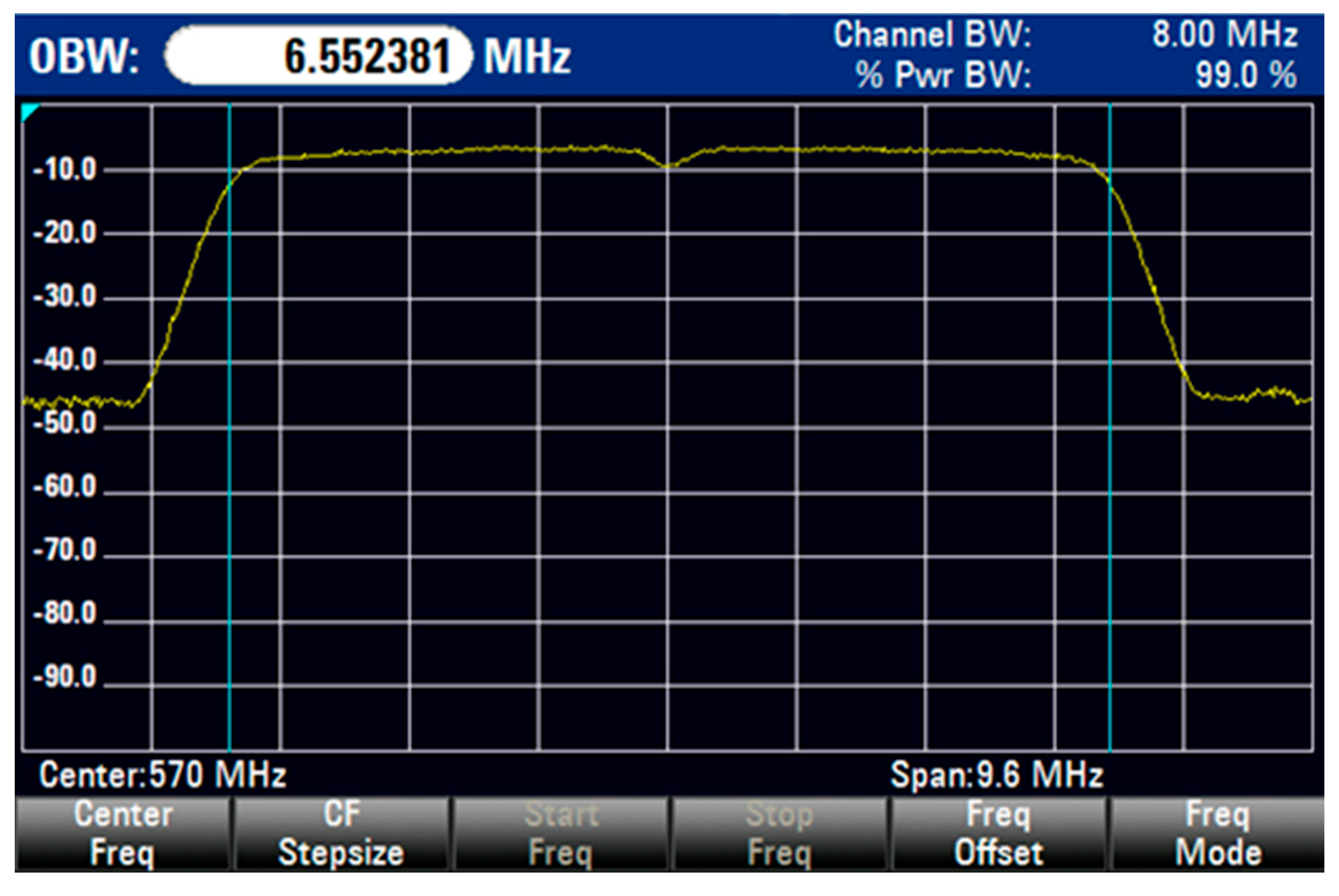
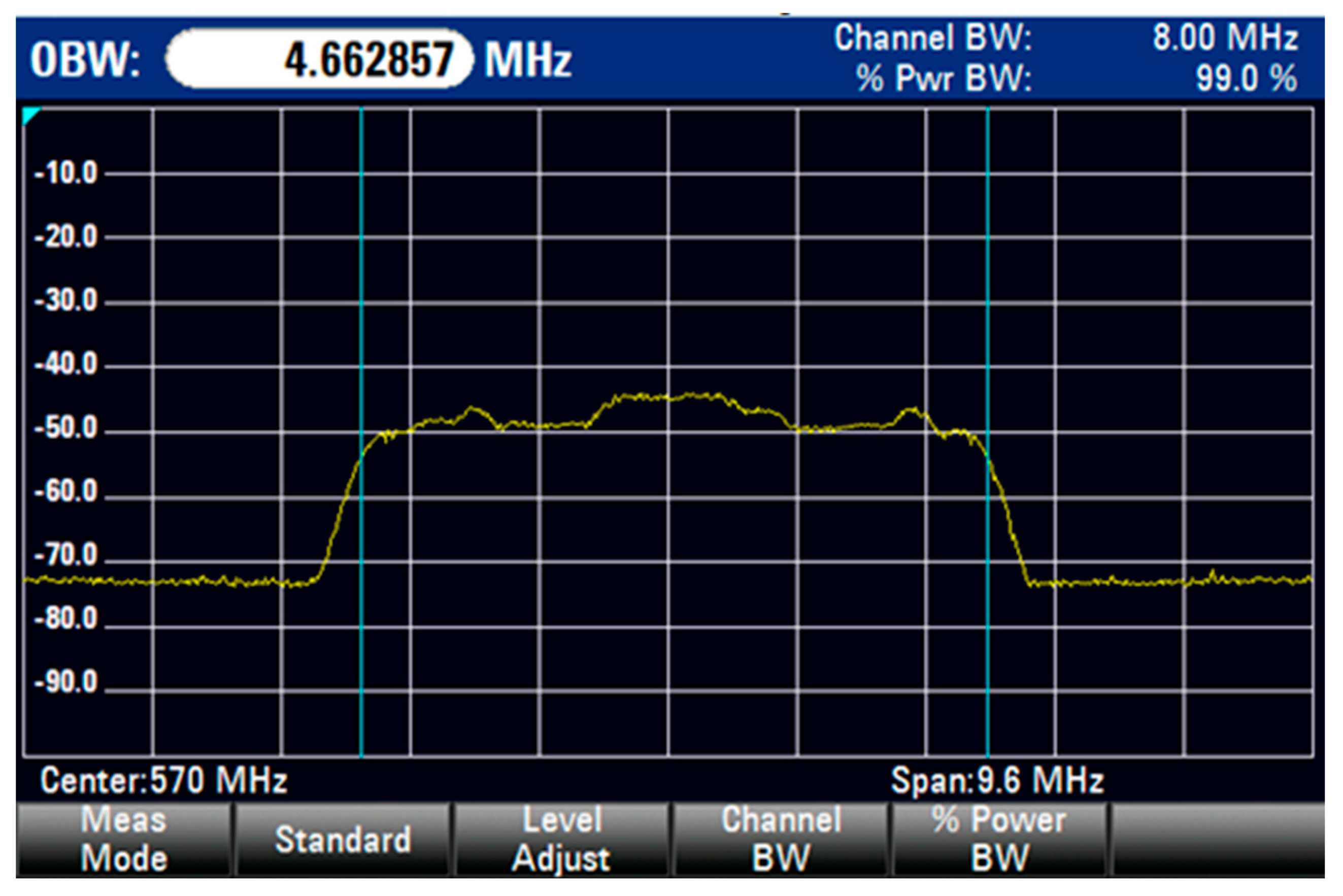
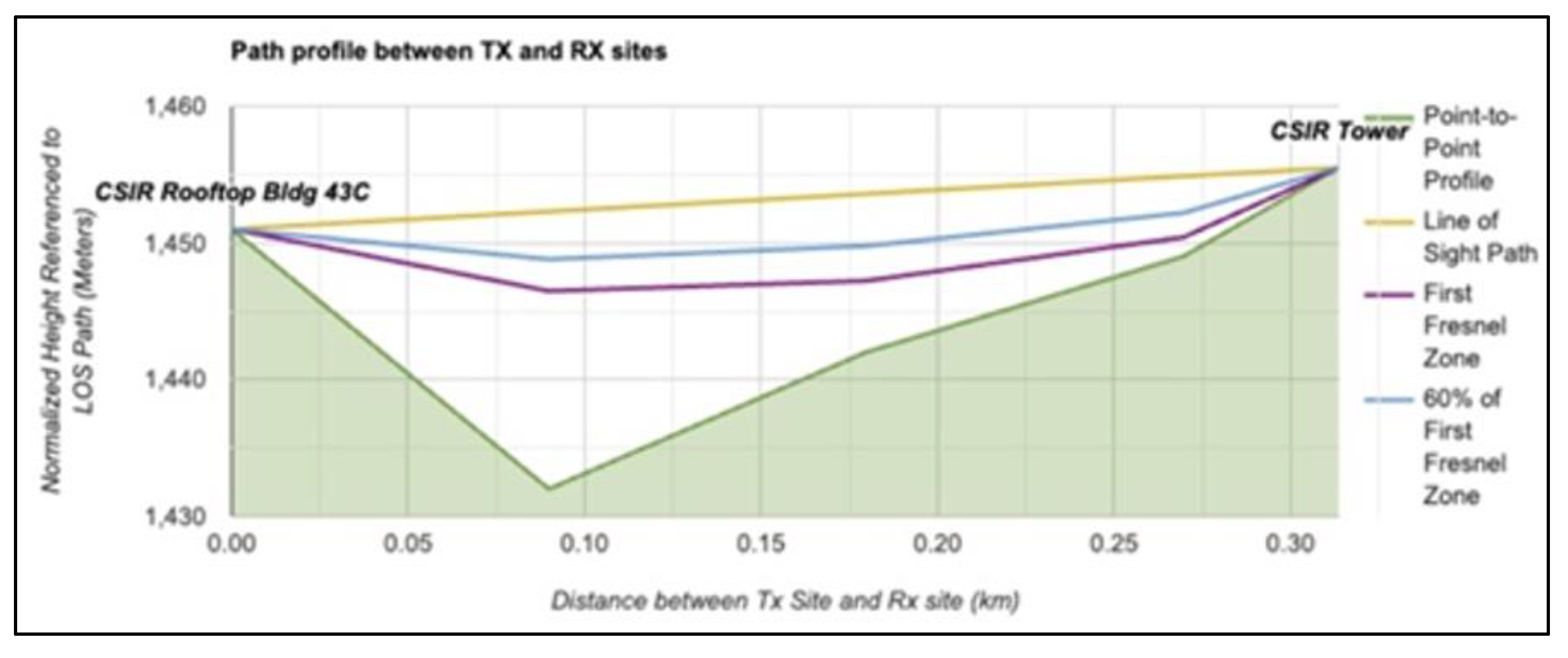


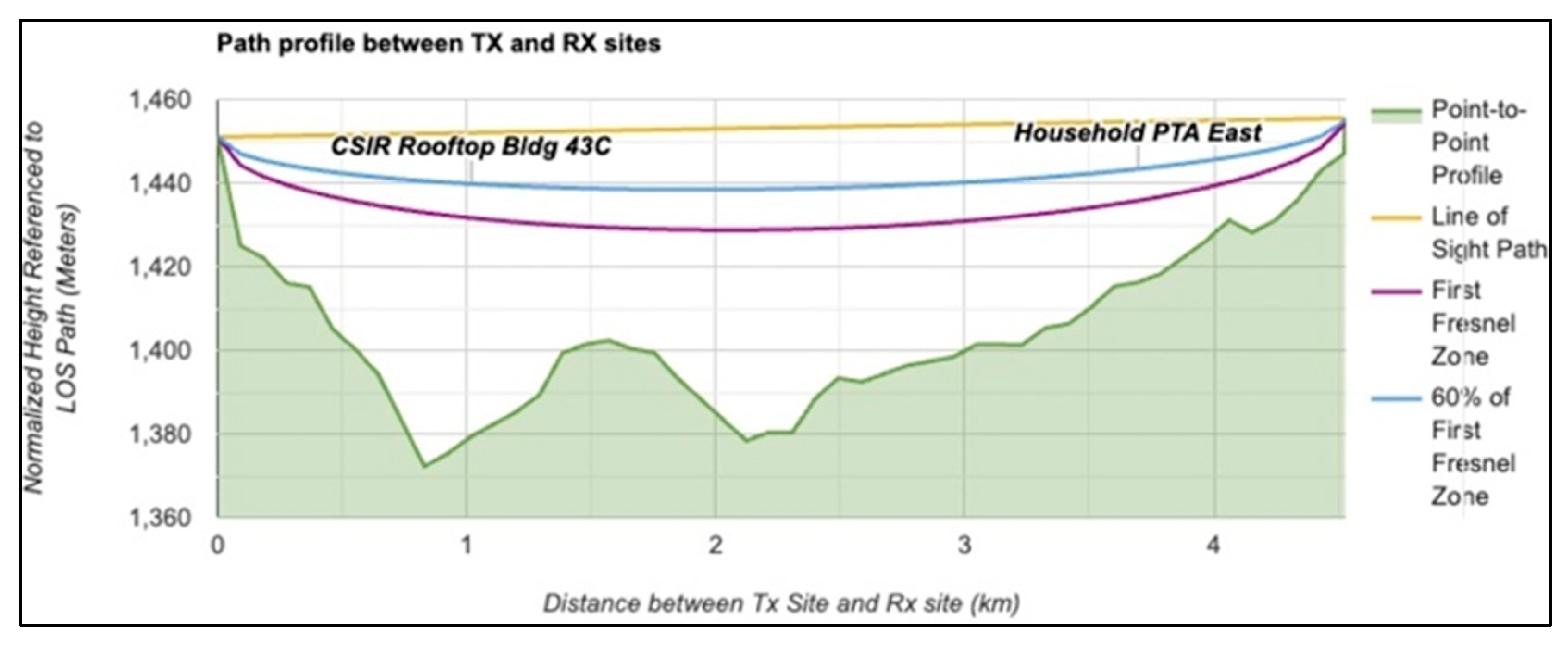



| WSD | |||
|---|---|---|---|
| OEM 1 | OEM 2 | OEM 3 | |
| Tx Power EIRP (dBm) | 27 +/− 2 dB | 35 | Master: 36 Client: 33 |
| Duplex Mode | TDD | TDD | TDD, FDD |
| Frequency Range (MHz) | 470–698 | 470–698 | 470–698 |
| Receiver Sensitivity (dBm) | −98 | −98 | −104 |
| Average Receiver Noise Figure (dB) | 5 | 5 | 5 |
| Channel Bandwidth (MHz) | 6, 8, 12 | 6, 7, 8 | 5, 6, 8, 10, 20 |
| Career Aggregation | No | No | Yes |
| Wireless Standard | 802.11af | 802.11af | 3GPP LTE-A |
| Modulation Scheme and Coding (MSC) | BPSK, QPSK, QAM 16, 64, 256 | BPSK, QAM 16, 64 | QPSK, QAM 16, 64, 256 |
| Waveform | OFDM | OFDM | OFDMA |
| GPS | Yes | Yes | Yes |
| PAWS RFC 7545 | Yes | Yes | Yes |
| Antenna | SISO | SISO | MIMO 2 × 2 |
| Network | Ethernet, IPv4/IPv6 | Ethernet, IPv4/IPv6 | Ethernet, IPv4/IPv6 |
| Software Version | 3.10.14 | 4.14.61 | LT100B_2.1.2489.1047 |
| Master Device | |||
|---|---|---|---|
| OEM 1 | OEM 2 | OEM 3 | |
| Tx Power EIRP (dBm) | 28 | 33 | 33 |
| TVWS Channel Number/Frequency (MHz) | 33 (570) | 33 (570) | 33 (570) |
| Antenna Gain (dBi) | 6 | 13 | 10 |
| MSC | auto | auto | auto |
| Channel Bandwidth (MHz) | 8 | 8 | 8 |
| Antenna Polarisation | Vertical | Vertical | Horizontal |
| Antenna Height (m) | 14 | 14 | 14 |
| Antenna Type | Yagi | Yagi | Panel Directional |
| Client Device | |||
|---|---|---|---|
| OEM 1 | OEM 2 | OEM 3 | |
| Tx Power EIRP (dBm) | 28 | 33 | 33 |
| Antenna Gain (dBi) | 5 | 10 | 10 |
| MSC | Auto | Auto | Auto |
| Channel Bandwidth (MHz) | 8 | 8 | 8 |
| Antenna Polarisation | Vertical | Vertical | Horizontal |
| Antenna Height (m) | 5.6 (Scenario 1), 8.5 (Scenario 2) | 5.6 (Scenario 1), 8.5 (Scenario 2) | 5.6 (Scenario 1), 8.5 (Scenario 2) |
| Antenna Type | Yagi | Yagi | Integrated |
| WSD | OEM 1 | OEM 2 | OEM 3 |
|---|---|---|---|
| SUE (%) | 81.9 | 81.9 | 58.29 |
| Radio Prop. Model | OEM 1 | OEM 2 | OEM 3 | |||
|---|---|---|---|---|---|---|
| Mean Measured (mW) | RMSE (mW) | Mean Measured (mW) | RMSE (mW) | Mean Measured (mW) | RMSE (mW) | |
| FSPL | ||||||
| ITM | ||||||
| Radio Prop. Model | OEM 1 | OEM 2 | OEM 3 | |||
|---|---|---|---|---|---|---|
| Mean Measured (Mbps) | RMSE (Mbps) | Mean Measured (Mbps) | RMSE (Mbps) | Mean Measured (Mbps) | RMSE (Mbps) | |
| FSPL | 20.1 | 115.1 | 17.1 | 131.39 | 15.4 | 133.09 |
| ITM | 154.27 | 169.76 | 179.44 | |||
| Radio Prop. Model | OEM 1 | OEM 2 | OEM 3 | |||
|---|---|---|---|---|---|---|
| Mean Measured (mW) | RMSE (mW) | Mean Measured (mW) | RMSE (mW) | Mean Measured (mW) | RMSE (mW) | |
| FSPL | ||||||
| ITM | ||||||
| Radio Prop. Model | OEM 1 | OEM 2 | OEM 3 | |||
|---|---|---|---|---|---|---|
| Mean Measured (Mbps) | RMSE (Mbps) | Mean Measured (Mbps) | RMSE (Mbps) | Mean Measured (Mbps) | RMSE (Mbps) | |
| FSPL | 9.16 | 12.14 | 15.73 | 17.55 | 11.8 | 21.48 |
| ITM | 115.6 | 97.94 | 109.0 | |||
Disclaimer/Publisher’s Note: The statements, opinions and data contained in all publications are solely those of the individual author(s) and contributor(s) and not of MDPI and/or the editor(s). MDPI and/or the editor(s) disclaim responsibility for any injury to people or property resulting from any ideas, methods, instructions or products referred to in the content. |
© 2025 by the authors. Licensee MDPI, Basel, Switzerland. This article is an open access article distributed under the terms and conditions of the Creative Commons Attribution (CC BY) license (https://creativecommons.org/licenses/by/4.0/).
Share and Cite
Vilakazi, M.; Makaleng, K.; Ngcama, L.; Mofolo, M.; Mfupe, L. Performance Analysis of Multi-OEM TV White Space Radios in Outdoor Environments. Appl. Sci. 2025, 15, 9977. https://doi.org/10.3390/app15189977
Vilakazi M, Makaleng K, Ngcama L, Mofolo M, Mfupe L. Performance Analysis of Multi-OEM TV White Space Radios in Outdoor Environments. Applied Sciences. 2025; 15(18):9977. https://doi.org/10.3390/app15189977
Chicago/Turabian StyleVilakazi, Mla, Koketso Makaleng, Lwando Ngcama, Mofolo Mofolo, and Luzango Mfupe. 2025. "Performance Analysis of Multi-OEM TV White Space Radios in Outdoor Environments" Applied Sciences 15, no. 18: 9977. https://doi.org/10.3390/app15189977
APA StyleVilakazi, M., Makaleng, K., Ngcama, L., Mofolo, M., & Mfupe, L. (2025). Performance Analysis of Multi-OEM TV White Space Radios in Outdoor Environments. Applied Sciences, 15(18), 9977. https://doi.org/10.3390/app15189977





